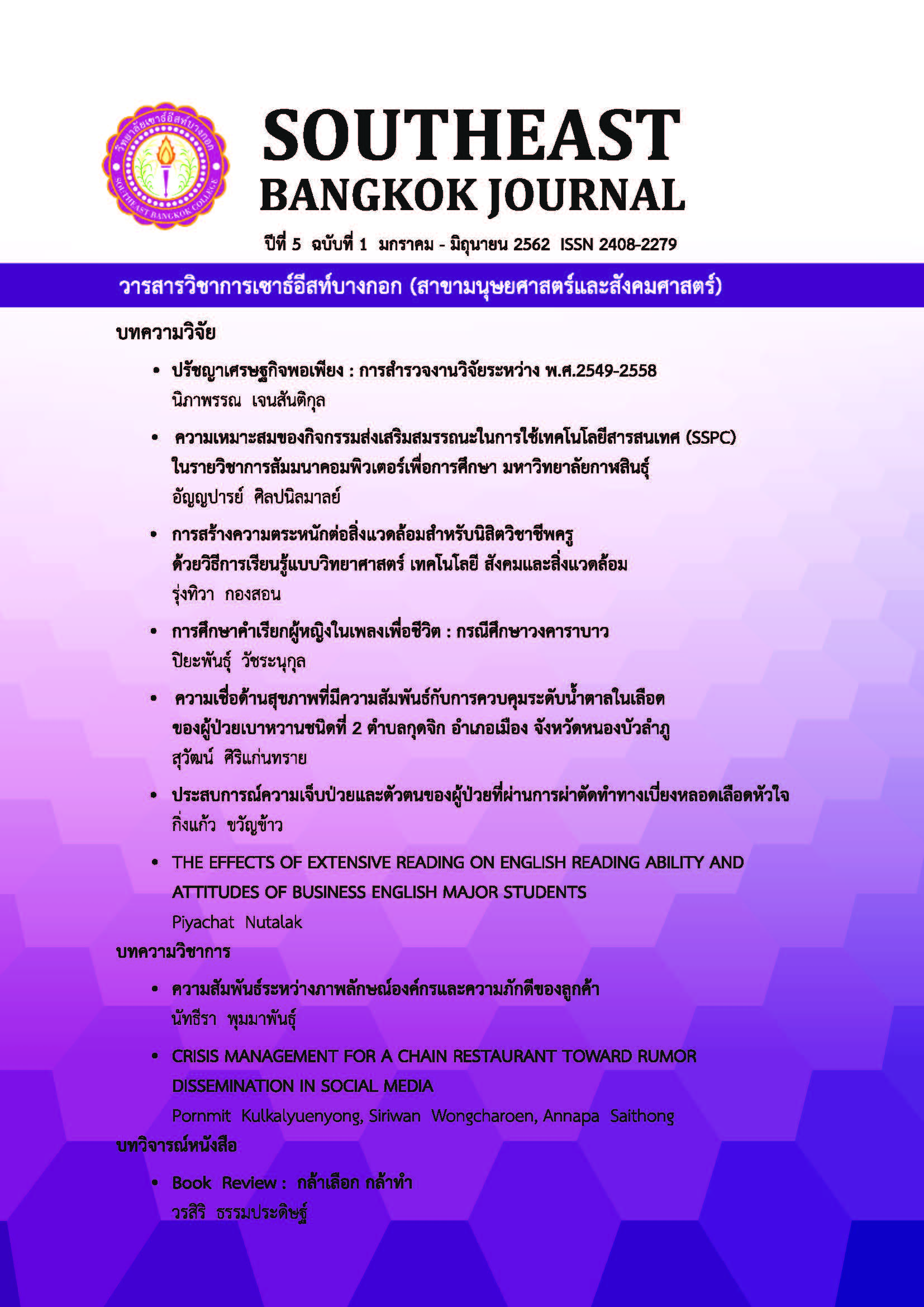ความสัมพันธ์ระหว่างภาพลักษณ์องค์กรและความภักดีของลูกค้า
Main Article Content
บทคัดย่อ
บบทความนี้มีวัตถุประสงค์เพื่ออธิบายความสัมพันธ์ระหว่างภาพลักษณ์องค์กรกับความภักดีของลูกค้า ด้วยเหตุผลที่ว่าภาพลักษณ์องค์กรเป็นปัจจัยหนึ่งที่ส่งผลต่อการดำเนินงานทั้งทางบวกและทางลบ ลูกค้าสามารถรับรู้ภาพลักษณ์องค์กรได้จากหลายปัจจัยซึ่งส่วนมากมาจากการสร้างขึ้นขององค์กรและนำเสนอผ่านสื่อต่าง ๆ ทั้งจากตัวสินค้า การบริการ ลักษณะทางกายภาพ บรรยากาศ บุคลากร สัญลักษณ์ ฯลฯ ภาพลักษณ์องค์กรมีผลต่อความรู้สึก ความคิด การยอมรับ ความต้องการของลูกค้า นำมาซึ่งความพอใจหรือไม่พอใจ มีผลต่อการตัดสินใจซื้อ การซื้อซ้ำและความภักดี จากการทบทวนพบว่าภาพลักษณ์องค์กรส่งผลต่อความภักดีของลูกค้า แต่ความภักดีของลูกค้าที่เกิดขึ้นนั้นอาจไม่เท่ากัน จะมากหรือน้อยขึ้นอยู่กับปัจจัยของลูกค้าแต่ละคนที่และองค์ประกอบที่แตกต่างกัน ดังนั้นองค์กรควรเข้าใจกลุ่มลูกค้าให้ดีก่อนสร้างและนำเสนอภาพลักษณ์องค์กรเพื่อให้ลูกค้าเกิดความพอใจและมีความภักดีในที่สุด
Article Details
References
จักรพันธ์ กิตตินรรัตน์. (2558). ความภักดีต่อผู้ให้บริการโทรศัพท์เคลื่อนที่ของนักศึกษาในสถาบันอุดมศึกษาเขตกรุงเทพมหานคร. วารสารเศรษฐศาสตร์และกลยุทธ์การจัดการ, 2(1), 25-42.
จิราภรณ์ สีขาว, 2560. สืบค้น http://www.thaihotelbusiness.com/articles.
โชคนิติ แสงลออ และ สุชาดา กรเพชรปาณี. (2558). โมเดลความสัมพันธ์เชิงสาเหตุความจงรักภักดีต่อแหล่งท่องเที่ยวในภาคตะวันออกของนักท่องเที่ยวชาวไทย. วารสารวิทยาการวิจัยและวิทยาการปัญญา, 12(2), 23-34.
ญรัญรัตน์ มณฑีรรัตน์ และ วิโรจน์ เจษฏาลักษณ์. (2558). การรับรู้ภาพลักษณ์ธนาคารที่ส่งผลต่อความจงรักภักดีต่อการใช้บริการผ่านคุณภาพการให้บริการของลูกค้าธนาคารกรุงศรีอยุธยาในเขตอำเภอเมือง จังหวัดนครปฐม. วารสารสาขามนุษยศาสตร์ สังคมศาสตร์และศิลป, 8(2), 877-892.
นันทสารี สุขโต, เพ็ญสิน ชวนะคุรุ, กุลทิวา โซ่เงิน, จิราพร ชมสวน, นวพงศ์ ตัณฑดิลก, วริศรา แหลมทอง, วัลภา หัตถกิจพาณิชกุล, วีรพล สวรรค์พิทักษ์ และสมศิริ วัฒนสิน. (2558). หลักการตลาด บริษัท เพียร์สัน เอ็ดดูเคชั่น อินโดไชน่า จำกัด. กรุงเทพ ฯ.
นันทมน ไชยโคตร. (2557). ภาพลักษณ์องค์กรและคุณภาพการให้บริการทีส่งผลต่อความจงรักภักดีของลูกค้าธนาคารออมสินในเขตบางแค. วิทยานิพนธ์ศิลปศาสตรมหาบัณฑิต. สาขาวิชาการจัดการภาครัฐและภาคเอกชน มหาวิทยาลัยศิลปากร.
พจน์ ใจชาญสุขกิจ. (2549). ยุทธศาสตร์การใช้การสื่อสารเชิงบูรณาการสร้าง Brand Image ของธนาคารพาณิชย์ไทยภายหลังวิกฤติการณ์ทางเศรษฐกิจในการแข่งขันธุรกิจธนาคารค้าปลีก.กรุงเทพฯ. บริษัทมิสเตอร์ก๊อปปี้ (ประเทศไทย) จำกัด.
รัชนี วงศ์สุมิตร. (2547). หลักการประชาสัมพันธ์. มหาวิทยาลัยบูรพา : ชลบุรี.
วันทนีย์ สิทธิอ่วม และปาริชาติ ราชประดิษฐ์. (2556). การศึกษาความสัมพันธ์ระหว่างความคาดหวังและการรับรู้คุณภาพการบริการกับภาพลักษณ์ของโรงแรม ในจังหวัดพิษณุโลกตามมุมมองของผู้ใช้บริการ. ปริญญาบริหารธุรกิจมหาบัณฑิตมหาวิทยาลัยนเรศวร.
วิมลมาศ ปฐมวณิชกุล. (2548). การประชาสัมพันธ์ทางการตลาด. คณะวิทยาการจัดการ มหาวิทยาลัยราชภัฎมหาสารคาม.
ศิริวรรณ เสรีรัตน์ & ปณิศา มีจินดา, (2554). การบริหารตราเชิงกลยุทธ์.บริษัทธรรมสารจำกัด.กรุงเทพฯ.
สุวิมล สุวรรณี, วีรยา ภัทรอาชาชัย และอารีรัตน์ แซ่คู. (2557). ผลกระทบของการประชาสัมพันธ์การตลาดเชิงกลยุทธ์ที่มีต่อภาพลักษณ์องค์กร ของธุรกิจโรงแรมในภาคตะวันออกเฉียงเหนือ. วารสารมนุษย์ศาสตร์และสังคมศาสตร์ มหาวิทยาลัยมหาสารคาม, 33(1), 236-247.
เสรี วงษ์มณฑา. (2541). ภาพพจน์นั้นสำคัญไฉน. กรุงเทพ ฯ. ธีระฟิล์มและไซเท็กซ์.
Aaker, D. A. (1991). Managing Brand Equity: Capitalizing on the Value of a Brand Name. New York: Free Press.
Baloglu, S., & Brinberg, D.(1997). Affective Images of Tourism Destinations. Journal ofTravel Research. 35(4). 11-15.
Boulding, Kenneth E. (1975). The Image : Knowledge in Life And Society.Michigan : The University of Michigan.
Boora,K.K., & Singh, H. (2011). Customer Loyalty and Its Antecedents : A Conceptual Framework. Asia Pacific Journal of Research in Business Management, 2(1), 151-164.
Bourdeau, L. B. (2005). A New Examination of Service Loyalty : Identification of the Antecedents and Outcomes of Additional Loyalty Framework. Doctoral Thesis. Florida University.
Bloenmer, J., Ruyter, K, & Peeters, P. (1998). Investigating Drivers of Bank Loyalty : The Complex Relationship Between Image Service Quality And Satisfaction. International Journal of Bank Marketing. 16(7). 276-286.
Bravo, R.,Montaner,T. & Pina.J.M. (2012). Corporate Brand Image of Financial Institutions : A Consumer Approach. Journal of Product & Brand Management, 21(4), 232-245.
Caruana, A. (2002). Service Loyalty: The Effects of Service Quality And The Mediating Role of Customer Satisfaction. European Journal of Marketing. 36(7/8). 811-828.
A, Dick & K, Basu. (1994). Customer Loyalty. Journal of the Academy of Marketing Science. 22(2). 99-113.
Fornell, C, Johnson, M.D., Anderson, E.W., Cha,J., & Bryant, B.E. (1996). The American Customer Satisfaction Index : Nature, Purpose and Findings. Journal of Marketing, 60(4),7- 18.
Georgc Christodoulides & Leslie de Chernatony. (2009). Consumer Based Brand Equity Conceptualization And Measurement. International Journal of Marketing,52(1), 43-65.
Greve, G. (2014). The Moderating Effect of Customer Engagement on the Brand Image-Brand Loyalty Relationship. Procedia-Social and Behavioural Science, 148, 203-210.
Hart, Allison E., Rosenberger & Philip J. (2004). The Effect of Corporate Image. The Formation of Customer Loyalty. Australasian Marketing Journal, 12(3), 88-96.
Huei, C. T., & Easvaralingam, Y. (2011). Perceptions of Service Quality, Corporate Image and Customer Loyalty in The Hotel Industry of Malaysia. Paper Presented at The 2nd International Research Symposium in Service Management. Yogyakarta, INDONESIA.
Ivanauskiene, N., & Auruskevicien, V., (2009). Loyalty Programs Challenges in Retail Banking Industry. Economics & Management Journal, 14(1), 407-412.
Jay Kandampully & Dwi Suhartanto. (2000). Customer Loyalty In The Hotel Industry : The Role of Customer Satisfaction And Image. International Journal of Contemporary Hospitality Management,12(6), 346–351.
Kotler,P., (2003). Marketing Management. 10 th Edition. New Jersey : Prentice-Hall Inc.
Ling Wang & Sirion Chaipoopirutana. (2014). The Influence of Perceived Service Quality, Coporate Image, Customer Satisfaction and Value on Customer Loyalty of Agriculture Bank of China in Kunming. International Conference on Trends in Economics : Humanities and Management (CTEHM 14), Aug 13-14. 172-176
Muhammad Salman, Noo Shariffr, Sufli Bin, Rabia Salman & Sadaf Hafeez. (2018). Coporate Socail Responsibility and Customer Loyalty in Islamic Banks of Pakistan: A Mediating Role of Brand Image. Academy of Accounting and Financial Studies Journal, 22(special), 1-6.
Naili Farida & Elia Ardyan. (2018). The Driving of Customer Loyalty : Relational Approach, Perceived Value and Corporate Image. International Journal of Business and Society, 19(1), 15-26.
Nguyen,N., & Leblance,G. (2010). Corporate Image and Corporate Reputation in Customer’Relation Decisions in Service. Journal of Retailing and Consumer Service, 8, 227-236.
Nukpezah,D., & Ngumuyo,C. (2010). What Drives Customer Loyalty and Profitability : Analysis of Perspectives from Retail Customers in Ghana’s Banking Industry. Sarbrucken : Lap Lambert Academic Publishing.
Pong, L. T., & Yee, T.P. (2001). An Integrated Model of Service Loyalty. In International Conferences Brussels,1-26.
Rasha Alieliwa. (2006). A Study of Customer Loyalty And The Image of The Finedining Restaurant. Master of Science. Oklahoma State University.
Shwu-Ing Wu & Yu-Hua Zheng. (2014). The Influence of Tourism Image and Activities Appeal on Tourist Loyalty : A Study of Tainan City in Taiwan. Journal of Management and Strategy, 5(4), 121-135.
Skogland. I., & Siguaw, J. A. (2004). Are Your Satisfaction Customer Loyal. Cornell Hotel and Restaurant Administration Quarterly, 45(3), 221-234.
Smith, P.R. & Zook, Z. (2012). Marketing Communications : Integrating Offline and Online with Social Media. 5th Edition. Philadelphia : Kogan Page Limited.
Tina Thomas Pummanchira. (2010). Facilitate Attraction : A Literatures Study on the Effect of Corporate Image on Recruitment. Tilburg University.
Veronika Bracinikova & Katerina Matusinska. (2018). Corporate Image of Banks from the Generation Y Perspective. ACTA Universitatis Agriculturae et Silviculturae Mendelianae Brunensis, 66, 441-451.
Zeithaml, V. A., Berry, L. L., & Parasuraman, A. (1996). The Behavioral Consequences of Service Quality. Journal of Marketing, 60(2), 31-46.

